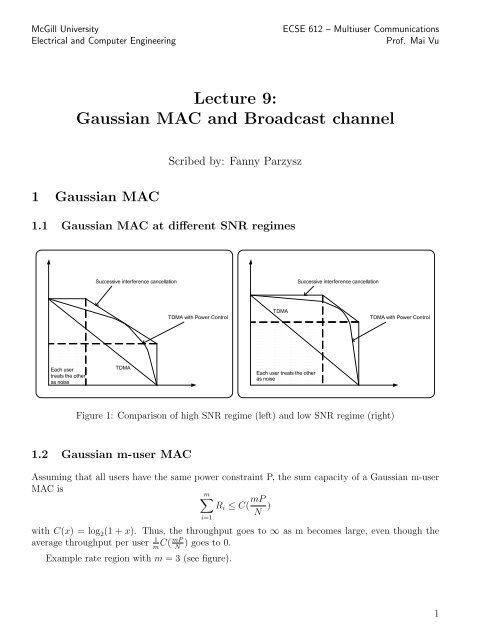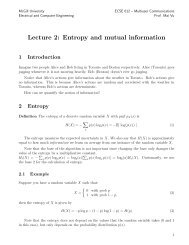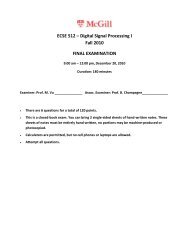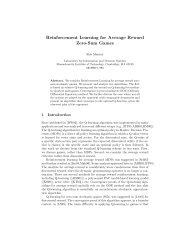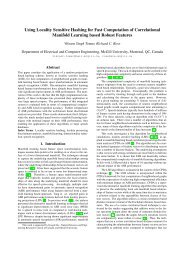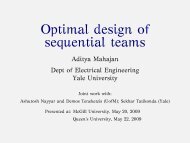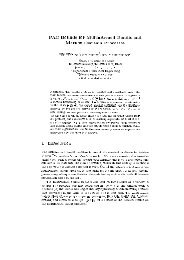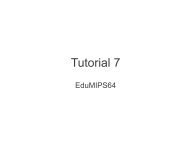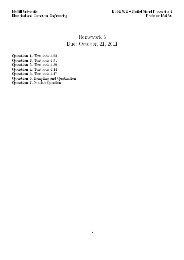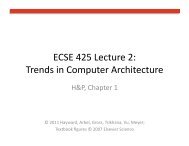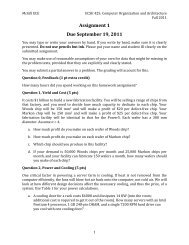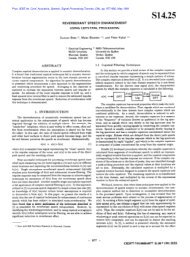Lecture 9: Gaussian MAC and Broadcast channel - Multiuser ...
Lecture 9: Gaussian MAC and Broadcast channel - Multiuser ...
Lecture 9: Gaussian MAC and Broadcast channel - Multiuser ...
You also want an ePaper? Increase the reach of your titles
YUMPU automatically turns print PDFs into web optimized ePapers that Google loves.
000000000000000000000000000000000000000000000000000000000000000000000000000000000000000000000000000000000000000000000000000000000000000000000000000000000000000000000000000000000000000000000000000000000000000000000000000000000000000000000000000000000000000000000000000000000000000000000000000000000000000000000000000000000000000000000000000000000000000000000000000000000000000000000000000000000000000000000000000000000000000000000000000000000000000000000000000000000000000000000000000000000000000000000000000000000000000000000000000000000000000000000000000000000000000000000000000000000000000000000000000000000000000000000000000000000000000000000000000000000000000000000000000000000000000000000000000000000000000000000000000000000000000000000000000000000000000000000000000000000000000000000000000000000000000000000000000000000000000000000000000000000000000000000000000000000000000000000000000000000000000000000000000000000000000000000000000000000000000000000000000000000000000000000000000000000000000000000000000000000000000000000000000000000000000000000000000000000000000000000000000000000000000000000000000000000000000000000000000000000000000000000000000000000000000000000000000000000000000000000000000000000000000000000000000000000000000000000000000000000000000000000000000000000000000000000000000000000000000000000000000000000000000000000000000000000000000000000000000000000000000000000000000000000000000000000000000000000000000000000000000000000000000000000000000000000000000000000000000000000000000000000000000000000000000000000000000000000000000000000000000000000000000000000000000000000000000000000000000000000000000000000000000000000000000000000000000000000000000000000000000000000000000000000000000000000000000000000000000000000000000000000000000000000000000000000000000000000000000000000000000000000000000000000000000000000000000000000000000000000000000000000000000000000000000000000000000000000000000000000000000000000000000000000000000000000000000000000000000000000000000000000000000000000000000000000000000000000000000000000000000000000000000000000000000000000000000000000000000000000000000000000000000000000000000000000000000000000000000000000000000000000000000000000000000000000000000000000000000000000000000000000000000000000000000000000000000000000000000000000000000000000000000000000000000000000000000000000000000000000000000000000000000000000000000000000000000000000000000000000000000000000000000000000000000000000000000000000000000000000000000000000000000000000000000000000000000000000000000000000000000000000000000000000000000000000000000000000000000000000000000000000000000000000000000000000000000000000000000000000000000000000000000000000000000000000000000000000000000000000000000000000000000000000000000000000000000000000000000000000000000000000000000000000000000000000000000000000000000000000000000000000000000000000000000000000000000000000000000000000000000000000000000000000000000000000000000000000000000000000000000000000000000000000000000000000000000000000000000000000000000000000000000000000000000000000000000000000000000000000000000000000000000000000000000000000000000000000000000000000000000000000000000000000000000000000000000000000000000000000000000000000000000000000000000000000000000000000000000000000000000000000000000000000000000000000000000000000000000000000000000000000000000000000000000000000000000000000000000000000000000000000000000000000000000000000000000000000000000000000000000000000000000000000000000000000000000000000000000000000000000000000000000000000000000000000000000000000000000000000000000000000000000000000000000000000000000000000000000000000000000000000000000000000000000000000000000000000000000000000000000000000000000000000000000000000000000000000000000000000000000000000000000000000000000000000000000000000000000000000000000000000000000000000000000000000000000000000000000000000000000000000000000000000000000000000000000000000000000000000000000000000000000000000000000000000000000000000000000000000000000000000000000000000000000000000000000000000000000000000000000000000000000000000000000000000000000000000000000000000000000000000000000000000000000000000000000000000000000000000000000000000000000000000000000000000000000000000000000000000000000000000000000000000000000000000000000000000000000000000000000000000000000000000000000000000000000000000000000000000000000000000000000000000000000000000000McGill UniversityElectrical <strong>and</strong> Computer EngineeringECSE 612 – <strong>Multiuser</strong> CommunicationsProf. Mai Vu<strong>Lecture</strong> 9:<strong>Gaussian</strong> <strong>MAC</strong> <strong>and</strong> <strong>Broadcast</strong> <strong>channel</strong>Scribed by: Fanny Parzysz1 <strong>Gaussian</strong> <strong>MAC</strong>1.1 <strong>Gaussian</strong> <strong>MAC</strong> at different SNR regimesSuccessive interference cancellationSuccessive interference cancellationTDMA with Power ControlTDMATDMA with Power ControlEach usertreats the otheras noise00000000000000000000000000000000000000000000000000000000000000000000000000000TDMAEach user treats the otheras noiseFigure 1: Comparison of high SNR regime (left) <strong>and</strong> low SNR regime (right)1.2 <strong>Gaussian</strong> m-user <strong>MAC</strong>Assuming that all users have the same power constraint P, the sum capacity of a <strong>Gaussian</strong> m-user<strong>MAC</strong> ism∑R i ≤ C( mPN )i=1with C(x) = log 2 (1 + x). Thus, the throughput goes to ∞ as m becomes large, even though theaverage throughput per user 1 m C(mP ) goes to 0.NExample rate region with m = 3 (see figure).1
McGill UniversityElectrical <strong>and</strong> Computer EngineeringECSE 612 – <strong>Multiuser</strong> CommunicationsProf. Mai VuR2R 1R 3Figure 2: 3-user <strong>MAC</strong>Z 1 Z 2 Z rW 1Enc 1X n 11GainMatrix G1+++Y n 1Dec(W`1,W`2)X n 1rY n rW 2Enc 2X n 21GainMatrix G2X n 2r1.3 <strong>Gaussian</strong> vector-<strong>MAC</strong>Figure 3: <strong>Gaussian</strong> vector <strong>MAC</strong> modelThis can modelize an OFDM, a DSL system, or a MIMO <strong>channel</strong>. We havewith Z ∼ N(0,I r ). The power constraints followY = G 1 X 1 + G 2 X 2 + Z,E[X T i · X i ] ≤ P i ⇔ tr(Σ i ) ≤ P i , i = {1, 2}Based on the same arguments as the scalar <strong>Gaussian</strong> <strong>MAC</strong>, the optimal inputs are <strong>Gaussian</strong>X 1 ∼ N(0, Σ 1 ), X 2 ∼ N(0, Σ 2 ). The question is to find the optimal covariances to maximize therate region.R 1 ≤ 1 2 log det( G 1 Σ 1 G T 1 + I r)R 2 ≤ 1 2 log det( G 2 Σ 2 G T 2 + I r)R 1 + R 2 ≤ 1 2 log det( G 1 Σ 1 G T 1 + G 2 Σ 2 G T 2 + I r)2
McGill UniversityElectrical <strong>and</strong> Computer EngineeringECSE 612 – <strong>Multiuser</strong> CommunicationsProf. Mai VuIterative Waterfilling This algorithm is used to find the optimal Σ 1 <strong>and</strong> Σ 2 . User 1 performsthe single-user waterfilling algorithm considering G 2 X 2 + Z as noise. Then user 2 also performsthe single-user waterfilling algorithm, considering G 1 X 1 + Z as noise, but knowing Σ (1)1 . Next thisprocess is repeated several times. It can be proved that the iterative algorithm tends to an optimalsolution that maximizes the sum rate (R 1 + R 2 ) <strong>and</strong> converges quite fast.Iterative waterfilling is used for DSL. However, in this case, it is not a multiple access <strong>channel</strong>but an interference <strong>channel</strong>, thus, the waterfilling solution is not optimal anymore.2 <strong>Broadcast</strong> <strong>channel</strong> (BC)2.1 DefinitionsDefinition 1 A broadcast <strong>channel</strong> is described by the set {X, p(y 1 , y 2 | x), Y 1 xY 2 }.Definition 2 A (2 nR 0, 2 nR 1, 2 nR 2, n) code consists of:• 3 message sets: M i = {1...2 nR i} for i = {0, 1, 2}• 1 encoding function: X : M 0 xM 1 xM 2 −→ X• 2 separate decoding functions: g i : Y i −→ M 0 xM i for i = {1, 2}Definition 3 The average error probability is definied byP (n)e = Pr{( ˜W 0 , ˜W1 ) ≠ (W 0 , W 1 )or ( ˜W 0 , ˜W2 ) ≠ (W 0 , W 2 )}.Definition 4 A tuple-rate (R 0 ,R 1 ,R 2 ) is achievable if P (n)eall achievable rates. In general, the capacity region for the BC is not known.−→ 0. The capacity is the closure ofn→∞2.2 TheoremThe capacity region of a BC depends only on the conditional marginal distributions p(y 1 | x) <strong>and</strong>p(y 2 | x). Thus two <strong>channel</strong>s following p (1) (y 1 , y 2 | x) <strong>and</strong> p (2) (y 1 , y 2 | x) with the same marginalshave the same capacity.Sketch of the proof LetP (n)e2P (n)e1 = Pr{( ˜W 0 , ˜W1 ) ≠ (W 0 , W 1 )}P (n)e2 = Pr{( ˜W 0 , ˜W2 ) ≠ (W 0 , W 2 )}We have P e(n) ≤ P (n)e1 + P (n)e2 <strong>and</strong> max(P (n)e1 , P (n)e2 ) ≤ P e(n) , hence P e(n) −→ 0 iff P (n)e1 → 0 <strong>and</strong>→ 0. If the tuple-rate is achievable for marginals, it is also achievable for the joint distribution<strong>and</strong> vice versa.3


